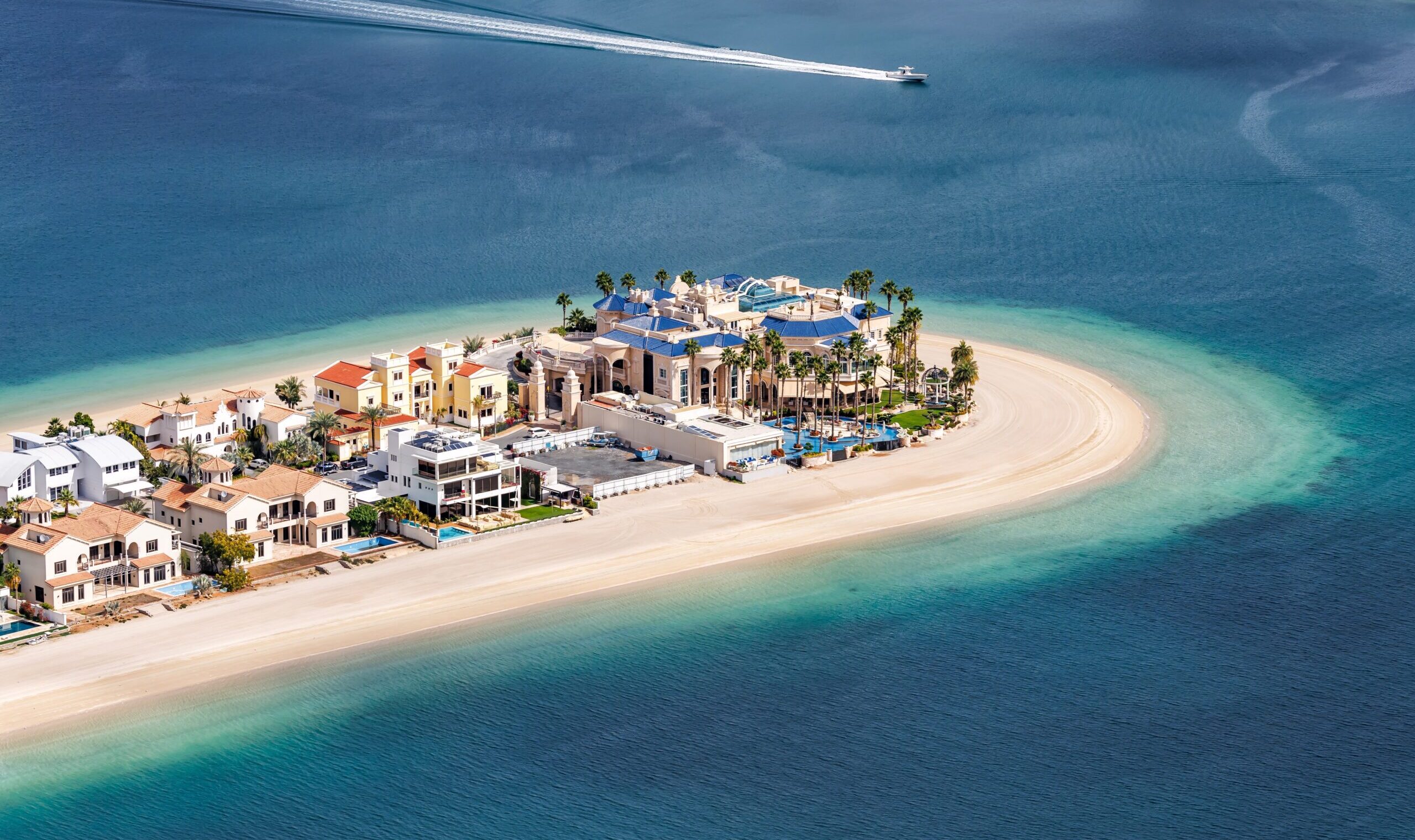The Scramble for Oceania
Start building artificial ocean platforms for fun and profit—and geopolitics.

News item: On April 17, an X feed called SkyFi took note of a “massive steel structure” that the People’s Republic of China had placed in the Yellow Sea, “sparking a standoff with South Korea’s coast guard.” So China has just built itself something that’s a military installation, or an artificial island—or both. By any name, it’s a topographical fact.
Newsweek adds, “China is building more island fortresses in the China Sea.” Moreover, the Center for Strategic and International Studies (CSIS) counts 27 PRC posts just on the Spratly and Paracel Islands, mostly created by pouring concrete atop coral reefs, establishing a port or airstrip, creating 3200 acres of new Chinese “land.” These spots are claimed by five other countries, but the PRC now holds them all.
We can see: China is engaged in slow-motion territorial expansion, filling in nearby seas. Does this portend the communist regime’s aggression against its neighbors? Perhaps.
Perhaps, therefore, this is a time for the U.S. to stand up for the “rules based order.” Perhaps we should reinvigorate our commitment to “protect sea lanes.” You know, make the “pivot to Asia.” Plenty of warriors, armchair and otherwise—from CSIS, to the Council on Foreign Relations, to the Pentagon’s Pacom, to startups in Prague—are already gaming out the scenarios.
But here’s another way of thinking about what the Chinese are doing: Maybe territorial expansion into the oceans is a smart idea per se. We don’t want international war, but national dynamism is okay. The Dutch, after all, have been peacefully reclaiming land from the sea for eight centuries, the U.S. has done plenty in the past, and other countries are at it, still, with spectacular success.
Leaving geopolitics aside for a moment, such expansion is surely good economics. It’s good, that is, to own more territory, and thus more resources.
So if the Chinese have their outward expansion into the sea; maybe we should have ours. Happily, irenically, our nearby oceans are mostly empty: We can expand into the Pacific, or the Atlantic—and to a lesser extent, the Gulf of America—without colliding into the claims of another country.
In the meantime, we can judge Chinese territorial revisionism however we wish. If American leaders are so inclined, they can dispatch sailors and soldiers to confront the Chicoms—and we’ll see how that turns out.
Yet even as we’re evaluating the power of our swords, we might also be thinking on the potential of our plowshares. Maybe, just maybe, we should pivot to America, seeing the outward revision of our seacoasts as an opportunity to enrich our homeland—a chance for us to gain more territory, more prosperity, and yes, more security. We’re safer, as well as richer, when we’re surrounded by…ourselves. So let’s get engineers and entrepreneurs on that mission. Make land, not war. The oceans, after all, account for some 140 million square miles, a full 71 percent of the Earth’s surface. So there’s plenty of room to expand—the oceans won’t notice.
Yes, it’s great that the Trump administration is opening up federal lands for development: These reforms will mean more housing and more domestic energy and other resource production. Yet at the same time, we can see the ceiling—the physical constraints of this nation, about 3.5 million square miles.
These constraints can be eased if we make full use of U.S. territories, beyond the 50 states. Here, too, Trump has been good: April 17, he reversed an Obama-administration decree that had locked up 500,000 square miles of the Pacific around American Samoa. The locked-down fishing grounds were a monument, proclaimed the Obamans. (A monument to what, we might ask, other than the vicarious green imperialism of the donor-class dots.) Today, the Samoans are happy, even as angry enviro groups plot their next lawsuit.
For those of us who believe in American Greatness, who think Manifest Destiny should never end, this is heartening. And yet we can do more. We can expand into empty places in the ocean, putting down anchors and drills—and perhaps concrete blocks made of captured carbon—and there’ll still be plenty of room for the seaweed and brine shrimp. (In fact, putting manmade objects permanently in the ocean often increases biological activity, by creating “reefs” in places that were once merely “deserts.”)
But what of other kinds of American expansion? What about, for instance, Greenland? This author is an on-the-record big fan of buying Greenland, but if it’s not for sale or swap, then its conquest isn’t worth the bones of a single American grenadier. As Operation Iraqi Freedom reminded us yet again, bloody imperialism just isn’t worth it.
Still, even if the Danes and Greenlanders prove impervious to our importuning, they might yet be jolted into developmental action: In the face of pressure from us, or the Russians or Chinese, they are coming to regard their territory as more than a miserly glacier preserve. And if Greenland opens up, that will create more opportunity for all, including Americans. (The same is true, by the way, for Ukraine—that embattled country is now realizing that dig, baby, dig is more important than staying green.)
Yet after all that world-surveying, we can come back to the simple pleasures of home: It’s easiest to expand on adjacency.
With that in mind, we might first think about military strategy: The U.S. possesses 11 aircraft carriers, each sailing the seas, holding a crew of 5,000, and costing $13 billion. CVs have been good at projecting force, but it’s unclear how good they will be at defending themselves against hypersonic missiles or drone swarms. Perhaps the Navy will figure this out—or perhaps carriers will go the way of cavalry.
In any case, effective defense is essential. Here again, the Chinese have the right idea: By building in the ocean, they are establishing a perimeter of sea-based sites, forward defenses their homeland, a permanent picket.
In that same spirit, we could think of islands—including manmade islands—as a defensive belt for Uncle Sam. Obviously we already have plenty of bases and airstrips on solid ground all across the Pacific, as well as across the world. But maybe we need more, especially as we take into account new military exigencies, as we think less about the Bush Doctrine of preemptive attack and more about the Monroe Doctrine of hemispheric defense.
With that in mind, maybe we should move away from aircraft carriers and toward aircraft stationers. Solid grounds for not only aircraft (manned and unmanned), but also, for lasers and other kinds of directed-energy weapons. To be sure, these fixed places would still be vulnerable; however, if they were cheaper to build, we could have many more of them. Also, being simpler to operate than a carrier, they could rely mostly on—or maybe completely on—robot crews.
Yet even as we eye military necessities, we should also be eyeing political and economic opportunities.
Here again, we can learn from the Chinese and their demonstrated knack for big public works. Most notably, the Great Wall of China not only helped defend the country, it helped define the country. Walls are salutary in many ways; they can be their own kind of nation-building. So now that the Chinese are building a Great Sea Wall, who can say that’s a mistake?
All the while, a larger dominion reaps economic rewards. For starters, there’s marine aquaculture: submersible pens for fish and other edibles. In China, this is a big business, impressively high tech. We can deplore Chinese fishing trawlers that “strip mine” the high seas. But only Greenpeace can oppose self-contained factory fish farms that keep people fed. (Greenpeace isn’t a factor in China, and, at last, it’s been pinned back, too, in the U.S.)
Indeed, as we gaze upon the oceans’ economic vistas, we can espy the beginnings of a great game, the scramble for Oceania. Winning is defined as controlling territory, wet as well as dry. To illustrate the value of geographic aggrandizement, we can consider Russia. It’s said to be resource-rich, and it is. Yet it’s not because Providence has uniquely blessed it; it’s because it’s huge. If you have 6.6 million square miles of land, you’re going to find something on it or underneath it—indeed, lots of things.
The same point applies to the globe’s 140 million square miles of ocean. All the surfaces of Earth have value, because resources are distributed across the planet, as randomly as the elements in the periodic table were scattered across the universe by the Big Bang. We can see this randomness if we look at gold mines, or oil reserves, or lithium deposits—or any sort of natural resource. They are legion.
Yet our economic assessments of riches are still mostly limited to what can be found under dry land—even as the other 71 percent of the world, the oceans, mostly still awaits tapping. (Seawater itself, all 352 trillion gallons of it, also has enormous economic potential.) To tap the seas fully will require better tech, of course, but also, clearer titles.
Amidst this wealth-assaying, where does seasteading fit in? Those libertarians are right: The ocean is the next frontier. Yet as with earlier frontiers, while they might start out as anything-goes “wild wests,” they always end up being controlled by nation-states.
Today, anything floating on, or sitting in, the ocean is vulnerable to pirates or terrorists or militaries—unless it can claim the sovereign authority of a state as its guarantor and defender. Always and forever in this world of armed men, Thomas Hobbes’s bleak wisdom looms large. So the seasteaders will have to strike a political bargain with some leviathan—a beast boasting a coast guard and a navy.
Still, the news isn’t bad for the seawardly mobile. As more technology is deployed into Neptune’s realm, as more people see blue water as an enterprise zone, at least some governments will deem this activity as beneficial and worthy of protection. Current history shows that nation states don’t have to strangle creativity and even arbitrage—they can, if they choose to, make it safe to flourish.
If the oceans, including the lands and structures we might build, are a good place to work, play, and invest, techno-bro visionaries will do well—even if they have to pay some taxes. Shakespeare might never have heard of seasteading, but he did know about seafaring, and colonies across the ocean, when he wrote, “There is a tide in the affairs of men, which taken at the flood, leads on to fortune.”
Still, many Americans, having been stuck in the greens’ Malthusian mind trap for so long, might need help grasping the full plenitude of oceanic opportunity.
So maybe it’s fortunate that China is ahead of us on infilling and ocean-constructing. How so? Because just as the Russians got into orbit first in the 1950s—which in turn energized the U.S. to win the space race of the ’60s—so today China’s lead in the “ocean race” could spur American competitiveness and effectiveness.
China’s tradition of civilizational bigthink, combined with its unsentimental, un-green nationalism, has served it well so far in this salty arena. For too long, the United States has been bewitched, bothered, and becalmed by nattering NIMBYs and Naderite naysayers who oppose everything. Yet now, in this Trumpian moment of go-go exuberance, Americans can reassert their inalienable rights: to life, liberty—and the pursuit of a newly made island.
The post The Scramble for Oceania appeared first on The American Conservative.

